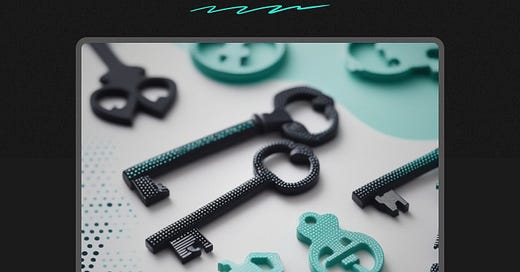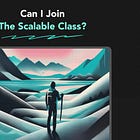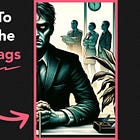3 Keys to Securing Great Work
Overcoming the objections that stand between you and your dream gig
Hello! I'm Pat, your guide to the business of creativity and innovation. New here? Join our supportive community to fuel your creative journey!
Securing great jobs in today’s competitive, remote work landscape is harder than ever.
As Gumroad founder Sahil Lavingia said:
Everyone loves remote work until they realize 7 billion people will soon be competing for the job they have.
The reality is that I’m no longer competing for design work alongside just the talent in my hometown of Los Angeles. I’m vying for projects and jobs against a worldwide pool of skilled designers.
Companies are adapting their hiring as a result, creating objections we need to remove to effectively sell our services in this merciless, global marketplace.
The Top Talent Objection – If a company is optimizing for talent, its selection standards become incredibly high. It seeks out only the “best of the best” globally.
The Cost Optimization Objection – If it’s optimizing for cost, a company may use geographic arbitrage to hire comparable talent for less money.
The Hiring Risk Objection – If a company is optimizing for managing risk, it may favor external agencies/contractors over full-time hires.
This confluence of forces means we, as designers, must bring an A+ effort to land the best work. It’s not about convincing anyone to hire us - it’s about systematically removing the objections that could prevent us from getting hired.
In this post, I’ll share three key strategies for overcoming these critical objections that stand between you and your dream gig. By focusing your efforts, you can position yourself as an irresistible candidate in the eyes of prospective clients and employers.
Let’s dive into the first strategy.
Strategy #1: Meet expectations for top talent
For companies optimizing to find the best talent, their selection standards have become incredibly high. They're only looking for the "best of the best" globally.
To remove this top talent objection, I have to ensure my online presence and personal brand positioning make it clear that I deserve a closer look. Even if my work and writing alone don't seal the deal, they need to open doors and keep me in the discussion.
This requires a significant investment of time and energy. But that's just the way the game is played now. I have to be willing to put in the work to elevate myself to the top of the global talent pool.
The key tactics I’m using to achieve this include:
Putting dozens of hours into a custom online portfolio that showcases my work
Regularly publishing writing that demonstrates my expertise
Building a strong personal brand and social media presence to increase my visibility
Continuously leveling up my abilities by being a Skill Surfer, ensuring I'm at the forefront of my craft
The goal is to make it crystal clear, at first glance, that I have the caliber of talent to deliver great results. While it takes effort, this hard-earned positive first impression can make or break introductions to new opportunities.
Strategy #2: Deliver unique, premium-worthy value
Once we've addressed the initial top talent hurdle, the next key objection we need to overcome is cost optimization. Many companies are now leveraging geographic arbitrage to find comparable design talent for lower compensation.
To overcome this objection, we need to deliver unique value that backs up a premium rate - value that isn't easily replicated elsewhere in the global marketplace.
As tech pioneer Kevin Kelly famously said, "Don't aim to be the best. Be the only."
At a global level, generic design services have become a commodity. However, if we can position ourselves as the only (or one of the few) viable options in a specific, high-value domain, we can command premium rates that reflect our scarcity.
For me, I've chosen to target a niche in professional tools and enterprise software design - with deep expertise in areas like cybersecurity, cloud infrastructure, data visualization, design systems, and other highly technical domains. My career path makes me a uniquely qualified candidate for this type of work. Few product designers combine my background across design, engineering, and brand strategy with experience designing three 9-10 figure B2B startups.
While I believe in generalist skills, I don't position myself as a generalist designer. Instead, I lean into my specialized expertise and background to make it clear that I'm not easily replaceable. I accept that I won’t be the right fit for every role, but if a company needs my specific skill set, they won't find it anywhere else.
The key is to identify the unique combination of skills, experience, and domain knowledge that sets you apart. What are the areas where you possess expertise that few others can match? How can you package and promote that premium value proposition?
By delivering this one-of-a-kind capability, you remove the cost-optimization objection and open the door to higher-paying, more fulfilling work.
Strategy #3: Reduce hiring risk for prospective employers
Finally, we need to overcome the hiring risk objection. Bringing on a new full-time employee can be a significant risk, both financially and culturally. Hiring the wrong person is not only expensive but can be disruptive for an organization.
To address this objection, we should keep an open mind about flexible work arrangements that reduce the hiring risk for prospective employers. Starting with a paid work trial or contract position can be a great way to build trust and familiarity, while also managing the risk for both parties.
After being laid off in 2020, I took on a 3-month full-time contract position as I was figuring out my next steps. This was during the height of the pandemic, and the company was understandably wary of bringing on new full-time staff. By starting with a contract, we were able to work together and build a good relationship. It helped me get my foot in the door at a time when it was otherwise impossible.
So don't be afraid to explore different, mutually beneficial work arrangements.
Reducing the company’s risk of hiring you might be the final hurdle to getting a “yes” instead of a “no.”
Final thoughts
I won’t sugarcoat it: securing great work takes a lot of effort, but the payoff is worth it.
The modern creative services marketplace demands grit and savvy.
To succeed in this environment, we must take a strategic, multi-faceted approach.
Focus your efforts on systematically removing the objections that stand between you and your dream gig. By following the three key tactics we covered - meeting expectations for top talent, delivering unique premium value, and reducing hiring risk - you can position yourself as an irresistible candidate.
If you’re reading this, I’m willing to bet you have what it takes to execute.
Now go make the magic happen.
Until next time,
Pat
If you got a little value from this post, consider subscribing or sharing. Follow me on X/Twitter and LinkedIn for daily posts.







Nice read! It's important to put in the work and skill stack whatever keeps you curious. I am also an undercover software engineer generalist, posing as a specialist whenever I have to.